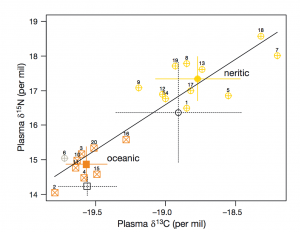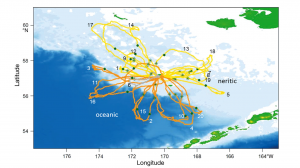Combining hard-part and DNA analyses of scats with biologging and stable isotopes can reveal different diet compositions and feeding strategies within a fur seal population
By Nicole Suren, SRC intern
Diet analysis of top predators is important in the study of ecology because it can help to illuminate the energetics and ecological interactions of that predator. One method of studying diet is using hard part analysis and DNA barcoding using the animals’ scats, while other methods include stable isotope analysis from blood plasma and an examination of behavior using satellite telemetry. Jenniard-du-Dot et al aimed to compare the effectiveness of these methods, and compile data from all four to obtain a full picture of the diets of 98 lactating females in an Alaska colony of fur seals. The hard part analysis consisted of straining the hard parts out of the seal scat and identifying the prey items they belonged to, and the DNA barcoding utilized the matrix of the scat to isolate the DNA of the various prey items. The two scat analyses were generally in agreement, with the more general classifications obtained from the hard part analysis confirmed and further specified by DNA analysis. While this information was useful, it only included data on what the seals had eaten in the last one to two days. To obtain longer-term data, the researchers used stable isotope analysis from blood plasma, which would give insight into the trophic level the seals had been feeding from for the previous one to two weeks. Finally, the seals were fixed with satellite tags for two months to examine where they were going to forage and what they might be eating there.

Results of the scat analyses. The percentage of the diet of the population of fur seals of many different species confirmed by hard part analysis and DNA barcoding are shown (Jeanniard-du-Dot, Thomas, Cherel, Trites, & Guinet, 2017).

Results of the stable isotope analysis. Levels of carbon (x-axis) and nitrogen (y-axis) isotopes show two trophic clusters, one signifiying an oceanic (pelagic) diet, and one showing a neritic (inshore) diet.
The overall conclusions were that there were two separate foraging strategies within the population: neritic (inshore) foragers and offshore foragers. While the scat analyses may have hinted at this by identifying some exclusively offshore species in the seals’ diets, the other two methods illuminated this phenomenon. The stable isotope analysis identified the inshore trophic levels versus the offshore trophic levels in the respective individuals, and the satellite telemetry showed two distinct foraging patterns, shown in figure 3.

The foraging tracks of 20 satellite tagged fur seals show two distinct foraging patterns.
These findings are not only important in building the life histories of an Alaskan population of fur seals. They support some previous research demonstrating that generalist feeders are often made up of subsets of specialist individuals. Furthermore, they demonstrate the importance of mixed methods in ecology, and how using different methods to examine different timescales and aspects of the life history trait being examined (like combining direct diet analysis and behavior) results in a very thorough study that gives the trait a wider ecological context.
Works cited
Jeanniard-du-Dot, T., Thomas, A. C., Cherel, Y., Trites, A. W., & Guinet, C. (2017). Combining hard-part and DNA analyses of scats with biologging and stable isotopes can reveal different diet compositions and feeding strategies within a fur seal population, 584, 1–16.
